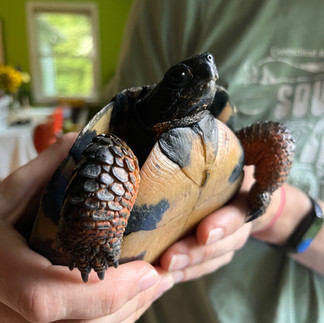How to Support Turtles and Their Habitats in the Connecticut River Watershed
- Laura Herbert

- Aug 12
- 3 min read
Updated: Aug 15

Let’s talk about turtles! The Connecticut River watershed is home to 7 species of turtles, 4 of which are listed as endangered, threatened, or of special concern in at least one state in the watershed—New Hampshire, Vermont, Massachusetts, and Connecticut. These include the eastern box turtle, wood turtle, spotted turtle, and northern diamondback terrapin. Among them, the wood turtle stands out as a species of special concern and is recognized as a high-priority species of greatest conservation need in all four states, underscoring the urgent need for coordinated conservation efforts across the region.
Turtles have survived since the age of dinosaurs. They have evolved to survive by being very long-lived. It takes years for a turtle to reach sexual maturity. Turtle eggs are often sought by predators, so turtles must mate and lay eggs many times before they are able to successfully replace themselves in the environment.
Unfortunately, turtle populations are plummeting due to collisions with cars, habitat loss, and illegal pet collection. Conflicts with cars and human development are causing them to perish faster than they can reproduce, with devastating impacts. Even the loss of one mature adult can cause a local population to collapse.
CRC’s Current Project for Wood Turtle Habitat Restoration
The Connecticut River Conservancy (CRC) has been working with The Orianne Society, a nonprofit organization dedicated to the conservation of reptiles, amphibians and the ecosystems they inhabit, on supporting turtle habitat since 2021. This collaboration involves outreach, habitat identification and site assessment, and delivery of on-the-ground conservation programs designed specifically to benefit Northeast turtles. Additional project components including water quality improvement through reductions in sediment and nutrients, riparian buffer plantings to improve habitat for rare freshwater turtles—especially wood turtles (Glyptemys insculpta) and spotted turtles (Clemmys guttata). Added benefits of such restoration projects implemented for turtles will also help many other species including blue-spotted salamander, New England cottontail, American bittern, wood duck, American woodcock, American black duck, moose, bob cat and brook trout.
Connecticut River Conservancy, The Orianne Society, and CT DEEP Wildlife Division will be hosting a public program on wood turtles at The Sessions Woods Conservation Education Center (341 Milford Street, Burlington, CT) at 6:30 PM on Thursday, September 25, 2025. This free program will cover wood turtle ecology, conservation concerns, and how you can help! Please fill out this form to register.
How to Support Turtles You May Encounter
Turtles can be found crossing roads from late April through early November (depending on location and climate conditions). May-mid to July is turtle nesting season, but turtles continue to move around to find new habitats and food sources. In the fall, they seek out a place to brumate (hibernate).
CRC's Staff Accountant Laura Herbert is a licensed wildlife rehabilitator who works with turtles as well as small mammals. Here is some advice she has to offer on how to help our chelonian friends:
If you see a turtle in your yard, just let it be. Turtles that are unbothered will not harm people (including children) or pets. Due to shrinking habitats, more turtles are being found nesting in yards and along driveways. If you encounter a turtle laying eggs, do not attempt to move her or the eggs once they are laid. If you think the eggs are in a dangerous location, please reach out to a wildlife rehabilitator. Only under the most serious circumstances should a nest be moved, and it must be done by an experienced wildlife professional to ensure that the eggs are not damaged.
If you see a turtle in the road, and if you can safely do so, please help it across the road in the direction it is going. If you see a turtle that has been hit, please contain it and call a wildlife rehabilitator (resource links below). If you leave it there and call someone to tell them where it is, it will be gone by the time help arrives. Make a note of exactly where you found it. Don’t assume it’s dead or dying. Turtles can survive severe injuries with proper medical care and attention.
If you find a dead turtle in the road during nesting season, contain it! Eggs are viable inside dead turtles for up to a week and can be extracted and incubated by a wildlife rehabilitator. Every turtle saved will help contribute to the health and vitality of our remarkable turtle populations and our watershed as a whole.
Above are some photos of the turtles Laura has supported, including the beloved snapping turtle, Oliver, who was hit by a car by the main stem in Northfield, MA and has since recovered and been released, as well as two beautiful wood turtles, one of which was a gravid female (containing eggs) which has since been released by MA Fish & Wildlife. Most of these turtles were hit by cars. Please slow down and keep an eye out for wildlife!
Links for wildlife rehabilitators in the Connecticut River watershed:














